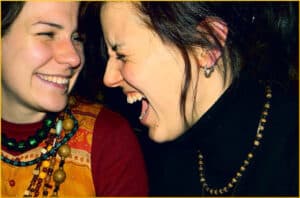
In an essay (as distinguished from a scientific paper) Basil Hugh Hall proposes that laughter is a displacement response — or at least, a phenomenon that parallels displacement activities, in being an effective alleviator of stress.
He establishes that displacement activities are likely to result from motivational ambivalence, anticipation of change in activity, actual change in activity, or internal conflict. (How, one might ask, is motivational ambivalence any different from internal conflict?)
This is a very long and complicated essay, so we will touch on only a few points. Here is an interesting thought:
The concepts of laughing with and at individuals have arisen due to a misunderstanding… I do not believe we laugh at, or laugh with, anyone, as the disinhibition of laughter is an involuntary response to conflict during event processing on a neurological level.
But here today we are not going that deep. When something is used for a different purpose than evolution intended it for, that’s exaptation. Hall’s piece is titled, “Laughter as an exapted displacement activity: the implications for humor theory.”
It is apparent how this makes sense in a very basic scenario, like the classic banana peel slip. The victim’s arms fly into the air; he drops any parcels he might be carrying; he makes hilarious faces and noises, and winds up butt-first on the ground. Which all seems, to any modern human, sufficient reason to laugh. But it goes much deeper.
Our ancestors
When a person sees someone fall, it provokes an instinctive response. If one member of the herd goes down, the enemy might also take down another member — namely, you. The sight of a fallen comrade is perceived as a threat, so the body gets ready to fight or flee (or perhaps to do one of the other displacement activities that have been discussed in recent posts.)
Or — the body laughs. Hall quotes an Oxford University Press dictionary that defines displacement activity as…
[…] the substitution of a irrelevant pattern of behaviour for behaviour that is appropriate to a particular situation, especially as a reaction to a conflict of motives.
Now, it makes even more sense. For most people, watching someone fall involves a conflict of motives. I, the onlooker, feel an impulse to flee from the unseen enemy. It is countermanded by the altruistic instinct to stay and help. On the third hand, even though my brain instantly computes that there is no physical danger, helping would simply be a lot of hassle. Either way, I want to get out of there. So instead, I laugh.
Hall refers to experts who say:
[H]uman laughter has its counterparts in the laughter-like behavior in the apes, it is likely that the evolutionary forerunner of human laughter was of value in intraspecific interactions in some primate groups including our hominid ancestors.
In this scenario, a “staccato vocalization” existed before language. For a band of apes ambushed by a predator, it is appropriate to scatter in panic — but not if this is a false alarm. The theory is that the alpha male would decide whether the threat was legitimate, and if not, would calm the group by producing “an audible and contagious displacement activity” that was the precursor of laughter.
But the late Mitch Hedberg, a revered comedian, could set up and almost complete a joke, and then pause, and wait. In few microseconds, the audience would deduce the punchline, and break into delighted laughter. It was telepathy, genius, magic — a whole different level of transaction. Obviously, there is a spectrum.
Your responses and feedback are welcome!
Source: “Laughter as an exapted displacement activity: the implications for humor theory,” ResearchGate.net, June 2009
Image by Anno Málie/Attribution 2.0 Generic (CC BY 2.0)

 FAQs and Media Requests:
FAQs and Media Requests: 












2 Responses
Hi Pat
You write, (How, one might ask, is motivational ambivalence any different from internal conflict?)
There is a difference between the brain weighing up two possible PHYSICAL responses to
REAL and IMMEDIATE external threats (which is a basic, instinctive response to fear) and the brain juggling two possible CONCEPTS that are not directly related to immediate and REAL external events. (flight/fight and telling jokes.)
If you pick up a piece of paper with a joke written on it you do not respond to it until you have read the words. The object itself engenders little or no emotive response and only when the words are internalised do you laugh.
The events and individuals described in the joke do not relate to an immediate external REALITY. This covers JOKES as I have indicated in my essay.
Thank you for making me think
Cheers
Basil Hall